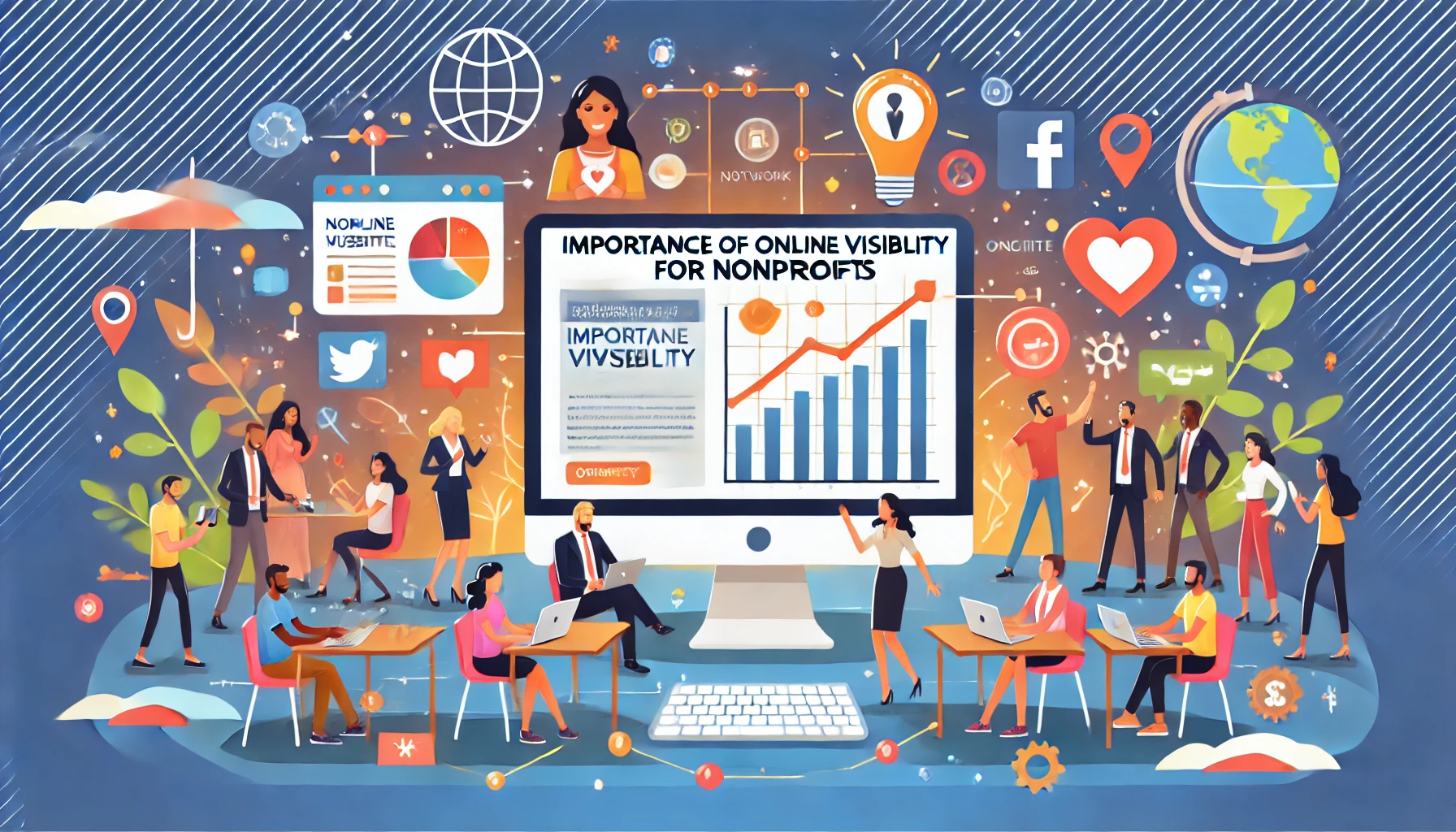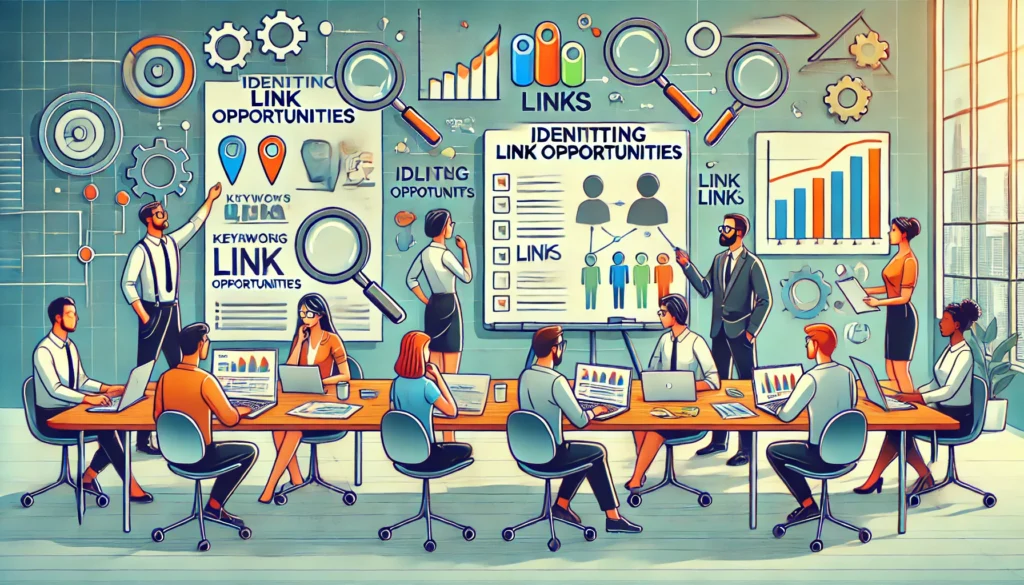In today’s digital age, establishing a strong online presence is crucial for nonprofit organizations to expand their reach and impact. Link building plays a pivotal role in enhancing visibility and credibility, ultimately driving donations, volunteer engagement, and community support.
Table of Contents
ToggleHow to do Link Building for Nonprofit Organizations

Link building for nonprofit organizations involves strategic efforts to enhance online visibility, attract support, and amplify impact through acquiring quality backlinks from reputable sources.
- Define Your Goals and Audience: Clarify your nonprofit’s objectives for link building, whether it’s increasing donations, raising awareness, or recruiting volunteers. Understand your target audience to tailor your outreach efforts effectively.
- Create Compelling Content: Develop valuable and shareable content such as success stories, informative articles, and engaging multimedia that resonate with your audience and encourage others to link back to your website.
- Identify Relevant Link Opportunities: Research and identify websites, blogs, and community organizations that align with your nonprofit’s mission and values. Seek out partnerships and collaborations that can lead to valuable link placements.
- Outreach and Relationship Building: Craft personalized outreach messages to potential partners, including influencers, bloggers, and local businesses. Build genuine relationships based on shared interests and goals to secure quality backlinks.
- Utilize Social Media and Digital Platforms: Promote your content and initiatives on social media platforms to engage followers and encourage them to share and link to your website. Collaborate with influencers and supporters to amplify your reach.
- Monitor and Measure Success: Use tools like Google Analytics to track referral traffic, monitor backlink performance, and assess the impact of your link-building efforts on key metrics such as website traffic, engagement, and donations.
- Adapt and Optimize Strategies: Analyze data regularly to identify what works best and adjust your link-building strategies accordingly. Stay informed about industry trends and opportunities to stay ahead in your outreach efforts.
Content Strategy: Developing compelling and informative content is the cornerstone of effective link-building. Nonprofits should focus on creating content that resonates with their audience—stories of impact, educational resources, or interactive campaigns—that are shareable and likely to attract links.
Identifying Link Opportunities: Researching and identifying relevant websites and blogs within the nonprofit sector and related fields is essential. Collaborating with local businesses, community organizations, and sponsors can also provide valuable link opportunities.
Outreach and Relationship Building: Personalized outreach efforts are key to securing links. Crafting tailored emails to potential partners, networking with influencers, and engaging with supportive communities can amplify link acquisition efforts.
Measuring Success: Utilizing tools to monitor backlinks and analyze referral traffic helps nonprofits gauge the effectiveness of their link-building strategies. By implementing ethical practices and maintaining transparency, nonprofits can build a robust online presence that supports their mission and fosters long-term sustainability.
Importance of Online Visibility for Nonprofits

In the digital era, establishing and maintaining a strong online presence is paramount for nonprofits to effectively achieve their missions and objectives.
Enhanced Reach and Awareness: Online visibility allows nonprofits to reach a broader audience beyond their local communities, raising awareness about their causes, programs, and impact on a global scale.
Increased Donations and Support: A visible online presence facilitates easier access for potential donors, supporters, and volunteers to learn about the organization’s work, donate securely, and get involved, thus boosting fundraising efforts and community support.
Credibility and Trust: A well-maintained online presence builds credibility and trust among stakeholders, including donors, partners, and beneficiaries, showcasing transparency, impact, and accountability through compelling stories, testimonials, and updates.
Advocacy and Influence: Nonprofits can leverage online platforms to advocate for policy changes, mobilize supporters for campaigns, and amplify their voices on social issues, thereby enhancing their influence and effecting positive change in society.
Definition of Link Building in the Nonprofit Context
Link building in the nonprofit context refers to the strategic process of acquiring hyperlinks from other websites to your nonprofit organization’s website to enhance online visibility, credibility, and engagement.
Enhancing Visibility: By securing links from reputable websites, nonprofits increase their visibility in search engine results and attract more organic traffic to their website, thereby reaching a broader audience interested in their cause.
Building Credibility: Backlinks from trusted sources validate the nonprofit’s authority and expertise in their field, establishing credibility among stakeholders, including donors, partners, and beneficiaries.
Driving Engagement: Links from relevant websites can drive referral traffic, encouraging visitors to explore the nonprofit’s mission, programs, and impact, ultimately fostering deeper engagement and support.
Supporting Fundraising Efforts: Effective link-building can contribute to increased donations and volunteerism by providing easier access for potential supporters to learn about the nonprofit’s initiatives and get involved.
Increased Donations, Volunteer Engagement, and Community Support
Nonprofits derive significant benefits from strategic link-building efforts, which directly contribute to increased donations, volunteer engagement, and community support.
Increased Donations: Effective link-building enhances the nonprofit’s online visibility, making it easier for potential donors to discover and support their cause. This heightened visibility not only attracts more visitors to the website but also encourages them to donate securely through convenient online platforms.
Volunteer Engagement: By securing links from relevant websites and communities, nonprofits can reach individuals passionate about their cause, fostering greater volunteer engagement. These volunteers are more likely to contribute their time and skills, furthering the organization’s mission and impact.
Community Support: Link building facilitates connections with local businesses, community organizations, and influencers who can advocate for the nonprofit’s initiatives. This support not only amplifies the nonprofit’s reach but also strengthens its ties within the community, creating a network of support that sustains long-term growth and impact.
Types of Content That Resonate with Donors, Volunteers, and Stakeholders
Creating compelling and relevant content is essential for nonprofits to engage donors, volunteers, and stakeholders effectively.
Impact Stories: Personal narratives and success stories that highlight the tangible impact of donations and volunteer efforts resonate deeply with supporters, showcasing how their contributions make a difference.
Educational Resources: Informative content such as guides, infographics, and videos that educate audiences about the nonprofit’s mission, challenges, and solutions can inspire deeper engagement and understanding.
Interactive Campaigns: Engaging campaigns such as fundraising challenges, online events, and interactive quizzes encourage active participation from supporters, fostering a sense of community and commitment.
Transparency and Accountability Reports: Detailed reports and updates on how donations are utilized, along with financial transparency, build trust and credibility among stakeholders, demonstrating responsible stewardship of resources.
Testimonials and Case Studies: Real-life testimonials from beneficiaries, volunteers, and supporters, as well as case studies showcasing successful initiatives, provide social proof of the nonprofit’s impact and effectiveness, inspiring confidence and continued support.
Identifying Link Opportunities

In the realm of nonprofit marketing, identifying and leveraging link opportunities is crucial for enhancing online visibility and attracting support from relevant audiences.
Research and Outreach: Conducting thorough research to identify websites, blogs, and online communities that align with the nonprofit’s mission and values is essential.
Local Partnerships: Building relationships with local businesses, community organizations, and educational institutions can provide valuable link opportunities through collaborations, sponsorships, and joint initiatives.
Industry Connections: Engaging with influencers, industry experts, and thought leaders in the nonprofit sector through networking events, conferences, and online forums can lead to valuable partnerships and link placements.
Content Contribution: Offering to contribute guest articles, interviews, or expert opinions to reputable websites and publications allows nonprofits to showcase their expertise and gain authoritative backlinks.
Monitoring Opportunities: Regularly monitoring online conversations, trends, and news related to the nonprofit’s focus area enables timely identification of opportunities for relevant link placements and partnerships.
Leveraging Partnerships with Local Businesses, Community Organizations, and Sponsors
Collaborating with local businesses, community organizations, and sponsors presents valuable opportunities for nonprofits to expand their reach, increase support, and amplify their impact.
Mutual Benefit: Partnerships are mutually beneficial, allowing nonprofits to tap into the resources, expertise, and networks of local entities while offering visibility and alignment with community-driven initiatives in return.
Shared Values and Goals: Aligning with partners who share similar values and goals strengthens the nonprofit’s credibility and enhances trust among stakeholders, fostering a cohesive approach towards addressing community needs.
Joint Campaigns and Events: Co-hosting events, fundraising drives, and awareness campaigns with partners not only amplifies outreach efforts but also cultivates a sense of unity and collective action within the community.
Resource Sharing: Collaborative efforts enable nonprofits to access additional resources, such as venue spaces, marketing channels, and volunteer pools, optimizing operational efficiency and impact.
Long-term Sustainability: Establishing long-term partnerships nurtures enduring relationships that support sustained growth, advocacy, and community engagement, contributing to lasting positive change.
Outreach and Relationship Building
Effective outreach and relationship building are essential for nonprofits seeking to cultivate meaningful connections, secure partnerships, and expand their support base.
Targeted Communication: Crafting personalized outreach messages tailored to the interests and values of potential partners, donors, and stakeholders demonstrates genuine interest and enhances engagement.
Building Trust: Engaging consistently and transparently through various channels, including email, social media, and in-person meetings, fosters trust and credibility.
Networking and Collaboration: Actively participating in industry events, conferences, and community gatherings provides opportunities to connect with influencers, experts, and like-minded organizations, paving the way for collaborative initiatives and shared advocacy efforts.
Acknowledgement and Appreciation: Recognizing and thanking supporters, whether through public acknowledgements, donor appreciation events, or personalized gratitude gestures, reinforces relationships and encourages continued engagement and support.
Follow-up and Feedback: Regularly following up with contacts and stakeholders to provide updates, seek feedback, and maintain open lines of communication strengthens relationships and demonstrates commitment to mutual growth and impact.
Networking with Influencers and Thought Leaders in the Nonprofit Sector
Networking with influencers and thought leaders in the nonprofit sector is instrumental for nonprofits looking to amplify their message, gain insights, and forge impactful partnerships.
Identifying Key Influencers: Researching and identifying influential figures, such as nonprofit executives, advocates, and prominent community leaders, helps nonprofits target individuals whose values and missions align with their own.
Building Relationships: Engaging authentically through social media interactions, attending industry events, and participating in online forums allows nonprofits to establish meaningful connections based on shared interests and goals.
Collaborative Initiatives: Collaborating on joint projects, campaigns, or events with influencers and thought leaders not only expands outreach but also lends credibility and authority to the nonprofit’s initiatives.
Amplifying Reach: Leveraging the networks and platforms of influencers to amplify awareness, drive engagement, and mobilize support for causes enhances the nonprofit’s visibility and influence within the community and beyond.
Continuous Engagement: Maintaining regular communication, providing value through shared resources or expertise, and reciprocating support help sustain long-term partnerships and foster a collaborative approach to addressing societal challenges.
Utilizing Social Media for Link Building
Social media platforms offer nonprofits powerful opportunities to enhance their online presence, engage with their audience, and build valuable links to their website.
Content Sharing: Posting engaging and relevant content, including blog articles, impact stories, and event updates, encourages followers to share links to the nonprofit’s website, increasing visibility and driving traffic.
Engagement and Interaction: Actively interacting with followers, responding to comments, and participating in discussions not only fosters a sense of community but also encourages users to link back to the nonprofit’s content.
Influencer Collaboration: Partnering with influencers and supporters on social media collaborations, such as guest posts, takeovers, or joint campaigns, can expand reach and attract new followers who are likely to share links to the nonprofit’s website.
Promotion of Campaigns and Initiatives: Using social media to promote fundraising campaigns, awareness drives, and volunteer opportunities encourages supporters to share links, amplifying the nonprofit’s message and impact.
Monitoring and Analytics: Utilizing social media analytics tools to track engagement, referral traffic, and the effectiveness of link-building efforts helps nonprofits refine their strategies and optimize content for maximum impact.
Engaging with Followers and Supporters to Amplify Reach and Influence
Engaging with followers and supporters is crucial for nonprofits aiming to expand their reach, foster community support, and enhance their influence in the digital space.
Interactive Content: Creating interactive content such as polls, Q&A sessions, and contests encourages active participation from followers, boosting engagement and increasing the likelihood of shares and referrals.
Responding and Acknowledging: Promptly responding to comments, messages, and feedback demonstrates attentiveness and appreciation, nurturing stronger relationships with supporters and encouraging continued interaction.
Encouraging User-Generated Content: Encouraging followers to share their stories, testimonials, and experiences related to the nonprofit’s mission empowers supporters and generates authentic content that can resonate with a wider audience.
Calls to Action: Including clear calls to action in posts, such as sharing content, donating, or volunteering, motivates followers to take meaningful actions that contribute to the nonprofit’s goals and increase organic reach.
Building Community: Facilitating discussions, highlighting supporter achievements, and celebrating milestones create a sense of belonging and inspire loyalty among followers, fostering a supportive community that advocates for the nonprofit’s cause.
Measuring Success: Monitoring and Analytics
Monitoring and analytics are essential for nonprofits to assess the effectiveness of their strategies, understand audience behaviour, and optimize their efforts for greater impact.
Tracking Key Metrics: Utilizing tools such as Google Analytics, social media insights, and email marketing platforms to track metrics such as website traffic, referral sources, engagement rates, and conversion rates provides valuable insights into the performance of link-building efforts.
Referral Traffic Analysis: Monitoring referral traffic from backlinks helps nonprofits identify high-performing sources and assess the quality and relevance of incoming links to their website.
Impact on Fundraising and Engagement: Analyzing the correlation between link-building activities and fundraising campaigns, volunteer sign-ups, and other engagement metrics helps nonprofits gauge the direct impact of link acquisition on their organizational goals.
Adjusting Strategies: Using data-driven insights to identify strengths, weaknesses, and opportunities enables nonprofits to refine their link-building strategies, optimize content, and allocate resources effectively for maximum impact.
Reporting and Transparency: Regularly reporting on analytics findings and sharing progress with stakeholders, including donors and board members, demonstrates accountability, informs strategic decisions, and builds trust in the nonprofit’s digital marketing efforts.
Lessons Learned and Actionable Insights
Reflecting on lessons learned from effective link-building efforts can provide valuable insights and actionable strategies for nonprofits looking to enhance their online presence and engagement.
Focus on Quality Over Quantity: Prioritize acquiring links from reputable and relevant websites that align with your nonprofit’s mission and values, as quality backlinks carry more weight in improving search engine rankings and driving meaningful traffic.
Build Relationships: Cultivating genuine relationships with influencers, community leaders, and industry peers can lead to organic link opportunities through collaborations, partnerships, and shared advocacy efforts.
Diversify Link-Building Tactics: Experiment with a variety of link-building tactics, including guest blogging, content partnerships, and social media engagements, to diversify your link profile and reach different audiences effectively.
Monitor and Adapt: Continuously monitor analytics data to assess the impact of link-building efforts on website traffic, engagement metrics, and fundraising outcomes. Use these insights to refine strategies, optimize content, and capitalize on emerging opportunities in the digital landscape.
Educate and Empower Supporters: Encourage supporters to advocate for your cause by sharing content, linking back to your website, and participating in online discussions, leveraging their networks to amplify your nonprofit’s reach and influence.
Conclusion:
In conclusion, effective link-building is not just about enhancing a nonprofit’s online visibility but also about fostering meaningful connections, amplifying community support, and driving impactful outcomes. By strategically acquiring high-quality backlinks, cultivating relationships with influencers and supporters, and leveraging digital platforms to engage and educate, nonprofits can significantly expand their reach and influence. Continuous monitoring of analytics provides insights to refine strategies and optimize efforts, ensuring sustained growth and success in advancing their missions. Embracing these practices empowers nonprofits to effectively navigate the digital landscape, ultimately maximizing their impact and creating lasting positive change in the communities they serve.





